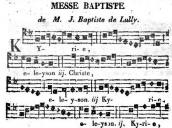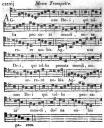J-B Lully: Messe Imperiale (Plein-Chant Musical)
-
For those with an interest in 17th & 18th Century French "Plein-Chant Musical" (such as the Messes Royales of Henri du Mont), I stumbled upon this Messe Imperiale by Jean-Baptiste Lully the other day.
The work is in a 19th century collection, titled "Notions et Exercices de Plainchant, ou Chant Ecclesiastique Romain, a l'usage de toutes dioceses". Link to the full book at the Bibliotheque nationale de France/Gallica: https://gallica.bnf.fr/ark:/12148/bpt6k9673439c/f5.image.r=Messe%20Pleinchant
I am attaching JPEGs of the six pages containing this Mass. (It would be great if someone fluent with Gregorio could type-set this in "Solesmes-style" neumes!)
 Lully_Messe_Imperiale_pg1.jpeg920 x 1566 - 238K
Lully_Messe_Imperiale_pg1.jpeg920 x 1566 - 238K
 Lully_Messe_Imperiale_pg2.jpeg940 x 1566 - 250K
Lully_Messe_Imperiale_pg2.jpeg940 x 1566 - 250K
 Lully_Messe_Imperiale_pg3.jpeg949 x 1566 - 250K
Lully_Messe_Imperiale_pg3.jpeg949 x 1566 - 250K
 Lully_Messe_Imperiale_pg4.jpeg936 x 1567 - 252K
Lully_Messe_Imperiale_pg4.jpeg936 x 1567 - 252K
 Lully_Messe_Imperiale_pg5.jpeg942 x 1566 - 241K
Lully_Messe_Imperiale_pg5.jpeg942 x 1566 - 241K
 Lully_Messe_Imperiale_pg6.jpeg936 x 1567 - 236K
Lully_Messe_Imperiale_pg6.jpeg936 x 1567 - 236K -
Back in mid-2015, purely for my own amusement, I made some Gregorio transcriptions of the Messe Baptiste ou Messe impériale de M. J. Baptiste de Lully from a source dated 1825, which I *think* match this; I don't seem to have made a transcription of the Gloria, for some odd reason.

 Messe Baptiste ou Impériale Kyrie.pdf17K
Messe Baptiste ou Impériale Kyrie.pdf17K
 Messe Baptiste ou Impériale Credo.pdf29K
Messe Baptiste ou Impériale Credo.pdf29K
 Messe Baptiste ou Impériale Sanctus.pdf23K
Messe Baptiste ou Impériale Sanctus.pdf23K
 Messe Baptiste ou Impériale Agnus Dei.pdf22K
Messe Baptiste ou Impériale Agnus Dei.pdf22K -
PS I have quickly churned out the Gloria - excuse any obvious typos, and note the sharp on the no- of the last nobis.
I would be interested to learn what others make of this Mass - it is at all singable?
 Messe Baptiste ou Impériale Gloria.pdf26K
Messe Baptiste ou Impériale Gloria.pdf26K -
It's interesting that there are many differences between your source and the 1866 book that I posted. Particularly, that the later source attributes it to the elder J-B Lully (+ 1687), whereas the earlier source to "le fils"; also the 1866 source is much more neumatic and melismatic than the 1825 source.
There are a few instances in the Gloria where I think (based on my source) B-molle should be B-durum, BUT, I'd have to see your source to be certain. -
it is at all singable?
I did trip once: the mixture of 4th & 6th leaps might be a challenge to the '4-lines good, 5 lines bad' line ;-) -
I am familiar with du Mont's VIth tone mass and have performed in recital its Gloria with G. Corrette's mass. Some of these plain chant musical versions would seem to be friends of Merbecke's 'for every syllable a note' principle. A guiding rationale for the plain chant musical genre was that it should be simpler and lacking in the melismaticisms of 'Gregorian' chant. However, in those chants of the mass, there really doesn't seem to be much difference, texturally, at all between a plain chant musical and a 'Gregorian' version. Interesting. The plain chant musical versions do have their own distinctive beauty.
-
For comparison with the files above, here are the primary sources from which I transcribed this Mass setting:

 Messe Baptiste 1.jpeg442 x 328 - 43K
Messe Baptiste 1.jpeg442 x 328 - 43K
 Messe Baptiste 2.jpeg440 x 812 - 107K
Messe Baptiste 2.jpeg440 x 812 - 107K
 Messe Baptiste 3.jpeg442 x 801 - 114K
Messe Baptiste 3.jpeg442 x 801 - 114K
 Messe Baptiste 4.jpeg438 x 823 - 116K
Messe Baptiste 4.jpeg438 x 823 - 116K
 Messe Baptiste 5.jpeg459 x 801 - 116K
Messe Baptiste 5.jpeg459 x 801 - 116K
 Messe Baptiste 6.jpeg440 x 808 - 108K
Messe Baptiste 6.jpeg440 x 808 - 108K
 Messe Baptiste 7.jpeg443 x 546 - 70K
Messe Baptiste 7.jpeg443 x 546 - 70K -
Out of interest, here are some notes I made about the author of this Mass:
Jean-Baptiste Lully fils (6 August 1665 to 9 March 1743) was the second son of the composer Jean-Baptiste Lully. He was also known as Baptiste Lully, Lully fils, l’abbé Lully, and Monsieur Baptiste. He was given the Abbey of Saint-Hilaire in 1678 (aged 12), which he exchanged six years later (aged 18, in 1684) for that of Saint-Georges-sur-Loire. He became superintendent of the King’s music (Surintendant de la Musique du Roi) in 1696, a position he shared with Michel-Richard de Lalande until 1719.
The Mass setting that he composed was known variously as:
La messe de J.-B. de Lully
Messe en plain-chant musical attribuée au fils de Lully
Messe Baptiste. 6e ton
Messe royale de Lully
Messe impériale. 6e ton
Missa imperialis
I assume that it was at first simply named after its author, then that title was shortened to "Baptiste", and, under influence of the more famous Messes royales of Dumont, came to be known as Lully's Royal Mass, and finally was accorded the lofty appellation of Imperial Mass - which title came to seem very fitting in the years of the First and Second French Empires.
Unfortunately I didn't record in what old book I found this quotation about this particular "musical plainchant" Mass setting, but here it is:
Le compositeur à la mode, le créateur de l'Opéra français, J.-B. Lully, écrivit, lui aussi, une messe en ce genre. Cette composition , du sixième mode, connue sous le nom de Messe Baptiste, mérite peu la faveur dont elle est encore aujourd'hui l'objet dans le midi de la France.
[The fashionable composer, the creator of the French Opera, J.-B. Lully, also wrote a mass in this genre. This composition, in the sixth mode, known under the name of Messe Baptiste, little deserves the favour of which it is still the object today in the south of France.]
-
I always find these old books so interesting!
I compared the two sources--most of the discrepancies occur in the Sanctus and Agnus Dei. The most notable difference through the entire piece is the two-note cadence: e.g.: Sol, Fa in the 1825 source are two clivises in the 1866 source: written La-Sol, Sol-Fa. The Amens of the Gloria are completely different in the two versions. The Kyries are basically identical, with the differences mainly being slight differences of syllable placing. Both sources could technically be correct in these regards (until an original MS is found in Lully's hand), because these things often circulated not in printed volumes, but in hand-copied choir-books at parishes, so I will not "correct" the melismata or text underlay of one source to the other.
I have two corrections which I think are corrections of printers' errors. One of the fun things of musicology: Proofreading & correcting 300-year-old mistakes!
In the Gloria: at "Domini Fili, unigenite, JESU CHRISTE" I would sharpen the B-flats (i.e., make B-natural) on Chri-ste, to match the nearly analogous part at "Qui sedes ad dexteram Patris, miserere NOBIS". (Sharps [naturals] are at both passages in the 1866 book.)
Also, the notes for "-tus. Tu solus [Dominus]." and "Tu" (of "Tu solus Altissimus") look like they've been misprinted in the source, up a step from where they ought to be. The 1866 book gives -tus(Sol-Fa). Tu(do) so(La)lus(Fa) Do(La)mi(Te)nus(Te-do). Tu(Do) so(Fa)lus(Re), etc., which better fits the mode, and removes the incredibly awkward melodic minor seventh at "-nus. Tu" (Do-Re). -
Does anyone know of a recording of this Mass?
-
Would these have been accompanied, using the methods described in treatises on organ playing?Thanked by 1Salieri
-
Most likely so.
(Which is yet another factor to consider when doing alternatim on recitals and such -
shall we have a serpent? fauxbourdon, etc.? [And, of course, serpentists are so easily come by].) -
And, of course, serpents are so easily come by.
I would LOVE to do a performance with serpent some day.
https://www.youtube.com/watch?v=fwShIY1GPW8
Welcome to the MusicaSacra Forum!
To participate in the discussions on Catholic church music, sign in or register as a forum member, The forum is a project of the Church Music Association of America.
Categories
- All Discussions21,110
- General Music Discussion8,218
- Job Openings197
- Management of Music Programs850
- Choral Matters533
- Church Documents and Rubrics524
- CMAA Notes302
- Events716
- For Newcomers: Read First26
- Sacred Polyphony546
- Hymnody872
- Gregorian Chant: General2,698
- ↳ Graduale Romanum and Liber Usualis368
- ↳ Graduale Simplex60
- ↳ Semiology63
- Vernacular Plainsong696
- Anglican Use and Anglican Chant68
- Organ, Other Instruments and Repertoire435
- New Composition/Works in Progress1,291
- Recordings232
- Music for Hispanic Ministry159
- Music Education: Children211
- Music Education: General222
- News Items245
- Positions Wanted2
- General Discussion: Catholicism739
- Amusements177
- General Discussion1,034
- Opinions117



